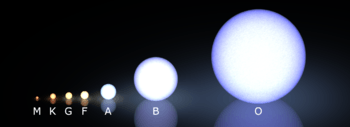HD 71334
| Observation data Epoch J2000 Equinox J2000 | |
|---|---|
| Constellation | Puppis[1] |
| Right ascension | 8h 25m 49.51538s[2] |
| Declination | −29° 55′ 50.1302″[2] |
| Apparent magnitude (V) | 7.8[3] |
| Characteristics | |
| Spectral type | G2.5V[4] |
| Astrometry | |
| Parallax (π) | 26.64 ± 0.78[2] mas |
| Distance | 122 ± 4 ly (38 ± 1 pc) |
| Details | |
| Mass | 0.94[3] M☉ |
| Surface gravity (log g) | 4.374[3] cgs |
| Temperature | 5,701[3] K |
| Metallicity [Fe/H] | −0.075[3] dex |
| Age | 8.1[3] Gyr |
| Other designations | |
| Database references | |
| SIMBAD | data |
| Data sources: | |
| Hipparcos Catalogue | |
HD 71334 is a Sun-like star 126.7 light years (38.85 parsecs) from the Sun. HD 150248 is a G-type star and a older solar analog. It is older than the sun at 8.1 billion years, compared to the sun at 4.6 billion years old. At 8.1 billion years old, HD 71334 has pasted its stable burning stage. HD 71334 has a lower metallicity that the Sun. HD 71334 is found in the constellations of Puppis. Puppis is one of the 88 modern constellations recognized by the International Astronomical Union. HD 71334 has a brightness of 7.8.
To date no solar twin with an exact match as that of the Sun has been found, however, there are some stars that come very close to being identical to that of the Sun, and are such considered solar twins by the majority of the public. An exact solar twin would be a G2V star with a 5,778K temperature, be 4.6 billion years old, with the correct metallicity and a 0.1% solar luminosity variation.[5] Stars with an age of 4.6 billion years are at the most stable state. Proper metallicity and size are also very important to low luminosity variation. [6][7][8]

Sun comparison
This chart compares the sun to HD 71334.
| Identifier | J2000 Coordinates | Distance (ly) |
Stellar Class |
Temperature (K) |
Metallicity (dex) |
Age (Gyr) |
Notes | |
|---|---|---|---|---|---|---|---|---|
| Right ascension | Declination | |||||||
| Sun | — | — | 0.00 | G2V | 5,778 | +0.00 | 4.6 | [9] |
| HD 71334 [10] | 08h 25m 49.5s | −29° 55′ 50″ | 124 | G2.5V | 5701 | −0.075 | 8.1 | [3] |
See also
References
- ↑ "HD 71334". Sky Map. 2009. Retrieved 2016-09-26.
- 1 2 3 Van Leeuwen, F. (2007). "Validation of the new Hipparcos reduction". Astronomy and Astrophysics. 474 (2): 653. Bibcode:2007A&A...474..653V. doi:10.1051/0004-6361:20078357.
- 1 2 3 4 5 6 7 Carlos, Marília; Nissen, Poul E.; Meléndez, Jorge (2016). "Correlation between lithium abundances and ages of solar twin stars". Astronomy & Astrophysics. 587: A100. arXiv:1601.05054
 . Bibcode:2016A&A...587A.100C. doi:10.1051/0004-6361/201527478.
. Bibcode:2016A&A...587A.100C. doi:10.1051/0004-6361/201527478. - ↑ Gray, R. O.; Corbally, C. J.; Garrison, R. F.; McFadden, M. T.; Bubar, E. J.; McGahee, C. E.; O'Donoghue, A. A.; Knox, E. R. (2006). "Contributions to the Nearby Stars (NStars) Project: Spectroscopy of Stars Earlier than M0 within 40 pc-The Southern Sample". The Astronomical Journal. 132: 161. Bibcode:2006AJ....132..161G. doi:10.1086/504637.
- ↑ NASA, Science News, Solar Variability and Terrestrial Climate, Jan. 8, 2013
- ↑ University of Nebraska-Lincoln astronomy education group, Stellar Luminosity Calculator
- ↑ National Center for Atmospheric Research, The Effects of Solar Variability on Earth's Climate, 2012 Report
- ↑ Most of Earth’s twins aren’t identical, by Ethan on June 5, 2013
- ↑ Williams, D.R. (2004). "Sun Fact Sheet". NASA. Retrieved 2009-06-23.
- ↑ HD 71334 at SIMBAD - Ids - Bibliography - Image.